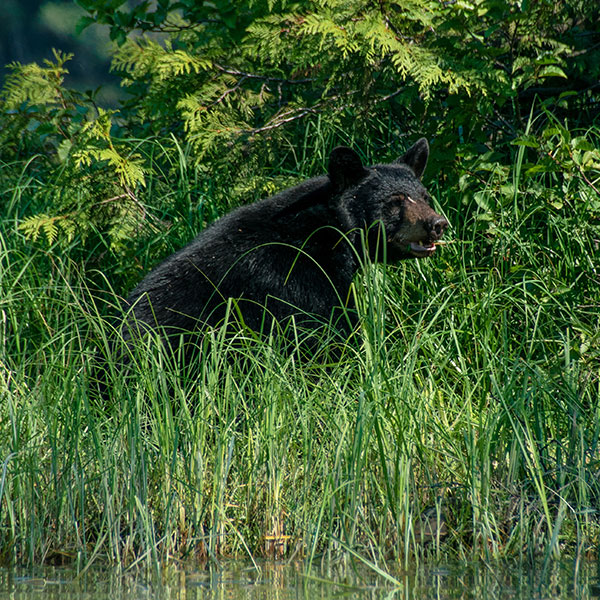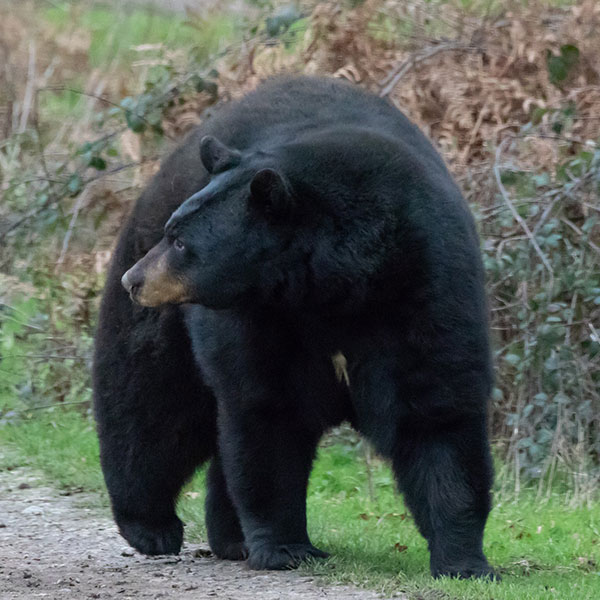There have been more and more bear sightings all across Texas in recent years, so we set out to explore where and why black bears are becoming more common. What we found was that there are actually 3 different subspecies that have been spotted, primarily in West and East Texas.
Are There Bears In Texas?
Yes, there are black bears in Texas! Most commonly seen in the far West Texas mountains or deep East Texas piney woods, black bears have been seen in Hill Country and near Lake Texoma.
Black Bears In West Texas
In West Texas, at least two subspecies of Black Bear are believed to live in Texas, the Mexican Black Bear and the New Mexico Black Bear. They inhabit desert scrub in scattered mountain ranges or woodland habitats, and live predominantly in the Chisos and Guadalupe Mountains.
Black Bears In Central Texas
The Texas Parks and Wildlife (TPWD) biologists encourage people to report recent bear sightings to the TPWD. The TPWD investigates each reported bear sighting. Biologists depend on reported Black Bear sightings to gain a better understanding of the recolonization rates of Black Bears in Texas.
From the Big Bend to Austin, bear sightings have surprised Texas biologists, and at least one sighting per year of Black Bears in the Hill Country is not uncommon.
Black Bears In East Texas
The American Black Bear subspecies, the Louisiana Black Bear, comprise a non-residential population in East Texas.
In Titus County, residents reported five Black Bear sightings reported by July 2020, but there have also been murmors of bear sightings as far west as Lake Texoma. This comes as no surprise to those that know that Louisiana, Arkansas and southeastern Oklahoma have been housing healthy populations of bears.



Why Are Black Bears In Texas?
Researchers believe these Louisiana Black Bears are primarily males searching for food, territory, or females to mate with. They are conducting a study in East Texas to determine habitat suitability in that part of Texas, where there is no stable breeding population of Black Bears. The TPWD began investigating and documenting Black Bear sightings in 1977.
Since 1977, it appears that a non-residential, primarily transient population of Black Bears are present in East Texas. The stable or growing populations of Black Bears in the surrounding states of Louisiana, Arkansas, and Oklahoma seem to be the reason for the growing presence of Black Bears in East Texas.
In West Texas, over the past several decades, the Black Bear is making a comeback into towns, where residents see the bears as a nuisance. In June 2020, the cities of Alpine, Fort Davis, and Fort Stockton saw an increase of Black Bear sightings. Technical guidance biologist with the Trans-Pecos division of TPWD reported in 2020, “It’s starting to indicate that the bears are making a comeback to West Texas and recolonizing dome of their former habitat such as the Davis Mountains.”
Black Bears are native to Texas, and they have inhabited Texas much longer than people realize. The Black Bears in West Texas are finding unoccupied habitat, meaning habitat void of bears, and moving back, including into West Texas cities. West Texas is seeing more bear sightings in the fall when food sources become scarce. The dry spring of 2020 drove the bears into West Texas towns searching for food.
There is a large area in the Mexican state of Chihuahua where Black Bears live, which is affecting the increase of them in West Texas. There are 23 Texas counties along the Texas/Mexico border that report Black Bear habitat. Seven of those West Texas Counties are confirmed Black Bear breeding grounds.
There are four panhandle counties with Black Bear sightings. In East Texas in the Ark-La-Tex region, six counties report sightings. One county in Texomaland and two counties south of DFW have Black Bear sightings. The Black Bears in the panhandle and Grayson County come in from Oklahoma, and the ones in Ark-La-Tex come from Arkansas, Louisiana, and Oklahoma.
Black Bear Conflicts
Black Bears create conflicts with people and their pets in towns and cities. When the bears smell food, it attracts them. Residents can secure food sources like garbage or pet food left outside unattended by keeping these sources locked up in a building. Deer and other wildlife feeders draw bear attention. Put hotwire or electrical fences around these wildlife food sources. These preventative measures do come at a cost, but the risks outweigh the costs.
The TPWD divides Black Bear sightings into a three-tiered classification system:
- Class I sightings provide verifiable physical evidence such as scat, a paw print, fur, or a photograph.
- Class II sightings are detailed accounts provided by an experienced observer such as a biologist or veteran outdoors person, but provide no physical evidence.
- Class III sightings include reported sightings that are vague and/or the account of the animal seen is not consistent with the image or behavior of a bear, or the investigation reveals falsification of essential facts.
Physical Features of Black Bears
Black Bears are stocky, large animals, and one of the largest mammals in North America. Adult Black Bears can reach a length up to five to six feet, a shoulder height of two to three feet, and weigh 200-300 pounds. Adult males are larger, with their weight ranging from 150 to 350 pounds, while females typically weigh 120 to 250 pounds. Bears walk flat-footed on their feet like humans.
The Black Bear’s fur color can range from black to cinnamon brown. Their front claws are usually longer than hind claws. Their fur is long and coarse. Black Bears are elusive and do not like human contact, but they can injure humans when provoked, and humans need to treat bear encounters with caution.
Behaviors of Black Bears
Black Bears living in forested regions are capable of climbing trees, but adult bears generally prefer to remain on the ground. Black Bears are crepuscular, which means that they are active at dawn and dusk. However, breeding and feeding activities at different times of the year can alter their behavioral patterns. Black Bears use day-bed sites in forested habitats when inactive, and these sites may consist of a shallow ground depression in the forest leaves.
Black Bears are true omnivores, and feed on a wide range of food source. Analysis of bear droppings show evidence that vegetable material usually consists of over half the bear’s diet. Insects and other animals make up a small percentage of their diet. Fresh berries, fruits, leaves, nuts, roots, and tubers are favorite food sources seasonally. They eat insects and small mammals when the opportunity arises.
Black Bears typically eat more when the summer season begins to progress. Signs of their activity increases at this time, and they leave obvious signs of their presence, such as scats on game trails, rotten logs broken open, large rocks overturned, opened yellow jacket nests, matted paths through berry patches, broken tree limbs, and climb marks on a variety of fruit producing trees.
Black Bears exhibit a high level of intelligence, are territorial, and show a high degree of curiosity. This explains their exploratory behavior. Black Bears will show threatening behavior by exhibiting different ear positions, body postures, and vocalizations. Normally, they will run and climb into the security of dense habitat when frightened or alarmed.
When vast amounts of natural food resources are available, female Black Bears may reach sexual maturity at two years of age. In other conditions, Black Bears reach sexual maturity from three to five years old. Their peak breeding season is in May and June. Black Bears are solitary animals, but during breeding season, females move through their home range distributing their scent and advertising their receptiveness to males. Males also increase their rates of movement looking for females, which leads them to lose up to 20% of their fall weight.
Black Bear mothers birth their cubs in a winter den. They usually have twins or one male and one female, but they can have a litter of one to five cubs. Their cubs weigh eight ounces when born, have no fur, and are entirely dependent for survival on their mothers. Cubs stay with their mothers during their first summer and fall and den with her their second winter.
Contrary to popular belief, Black Bears do not hibernate. Instead, they enter into a state of torpor. This means that the Black Bear’s metabolic rate decreases, and their activity slows or completely stops. In Texas, where we experience relatively mild winters, Black Bears might den for a period as few as two weeks or maybe not at all because of year round natural food source availability.
Texas Black Bear Questions
Bears are most commonly found in far West Texas and deep East Texas, however they have been recently spotted in the Red River Valley in North Texas, and Hill Country in Central Texas.
While bears do live in Texas, they are not as common as you might expect in the Rockies, Appalachians, or other mountainous areas with plenty of forage.
There are not any grizzly bears in Texas.
There are not any bears in Dallas Texas.